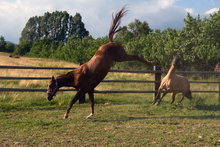With a turn of the shovel, Phase 1 construction has started on the new Texas A&M Equine Complex. At a total cost of $80 million when completed, the new complex will provide a home for equine science education, research and outreach.

More horse health support in Texas
Initial construction will include an education and outreach center, facilities for the Equestrian Team, a cross country course, and new facilities for the Parsons Mounted Cavalry.
Planning for the new center began in May 2012 when the Texas A&M Board of Regents approved negotiation of a ground lease with an anonymous donor that allowed for Phase 1 construction to begin. This cornerstone gift, combined with in-kind and other major gifts, bring support generated for Phase 1 construction to approximately $35 million.
Initial construction will include an education and outreach center, facilities for the Texas A&M Equestrian Team, a cross country course in collaboration with Texas A&M Athletics, and new facilities for the Parsons Mounted Cavalry.
With a long history of teaching, research, equine medicine, and outreach excellence, Texas A&M University has been a vital contributor to the equine industry for generations. Both the Department of Animal Science in the College of Agriculture and Life Sciences and the College of Veterinary Medicine & Biomedical Sciences have been instrumental in providing the equine industry with knowledge and care that have advanced not only equine sciences, but the welfare of the horse as well.
The Texas A&M Equine Initiative was created to collaboratively utilize existing expertise within the university to build an equine program that will graduate the industry’s future leaders and generate research and veterinary medical care that will improve the industry and the care and welfare of the horse.
To support its mission, the Equine Initiative has developed four major imperatives. In each of these areas, the focus will be to enhance and improve upon Texas A&M’s existing strengths. The four imperatives are curriculum enhancement, outreach & engagement expansion, facility construction, and partnership development.
About the College of Veterinary Medicine and Biomedical Sciences
From its early beginning in 1916, the Texas A&M College of Veterinary Medicine & Biomedical Sciences served the livestock industry in the State of Texas. Dr. Mark Francis, the first dean of the college, is credited with proving that the tick was responsible for Texas Cattle Fever – a disease that had plagued Texas cattle ranchers since the late 1700s.
Since that time, the CVM has grown to one of the largest colleges of veterinary medicine in the United States, and is home to internationally known faculty. Through commitment to teaching, research, and service, CVM faculty, staff, and students are making discoveries today that impact the health of humans and animals worldwide.
About the Department of Animal Science in the College of Agriculture and Life Sciences
The Department of Animal Science at Texas A&M University has achieved national and international prominence as the largest and most complex department of animal science in the nation. As part of its land grant mission, the Animal Science Department strives to meet the needs of all citizens by providing outstanding teaching, research, and extension programs.
Currently, disciplines within the department include reproductive physiology, animal breeding and genetics, food science, microbiology, equine science, dairy science, animal nutrition, and meat science. The department responds to the Texas animal industry through research and education programs in equine, beef, dairy, swine, sheep, and goats.
